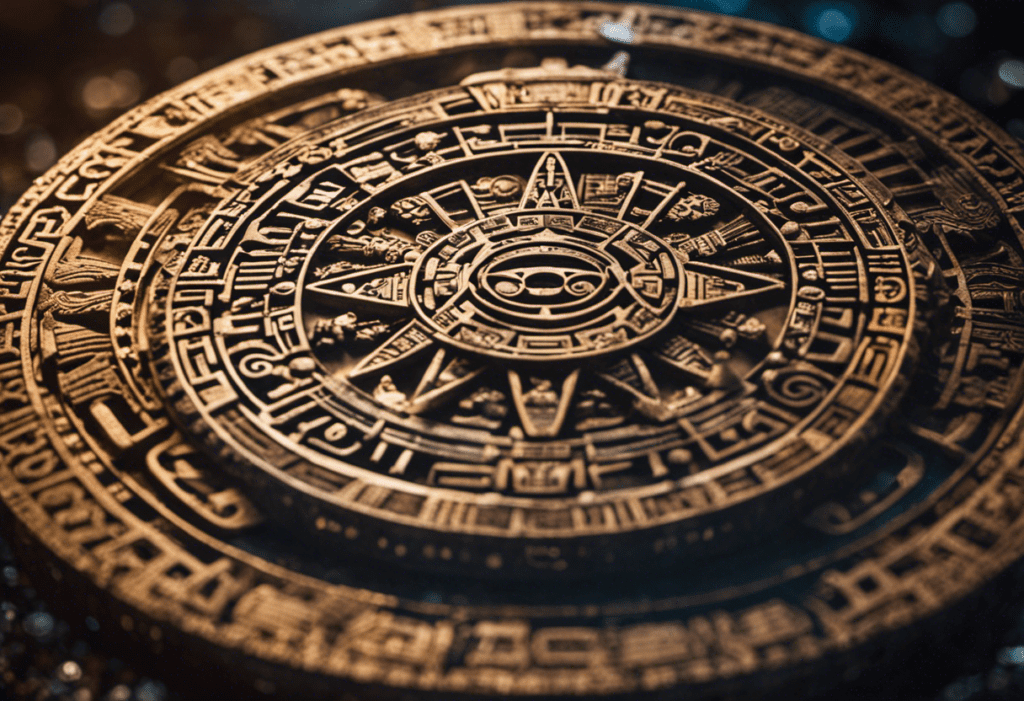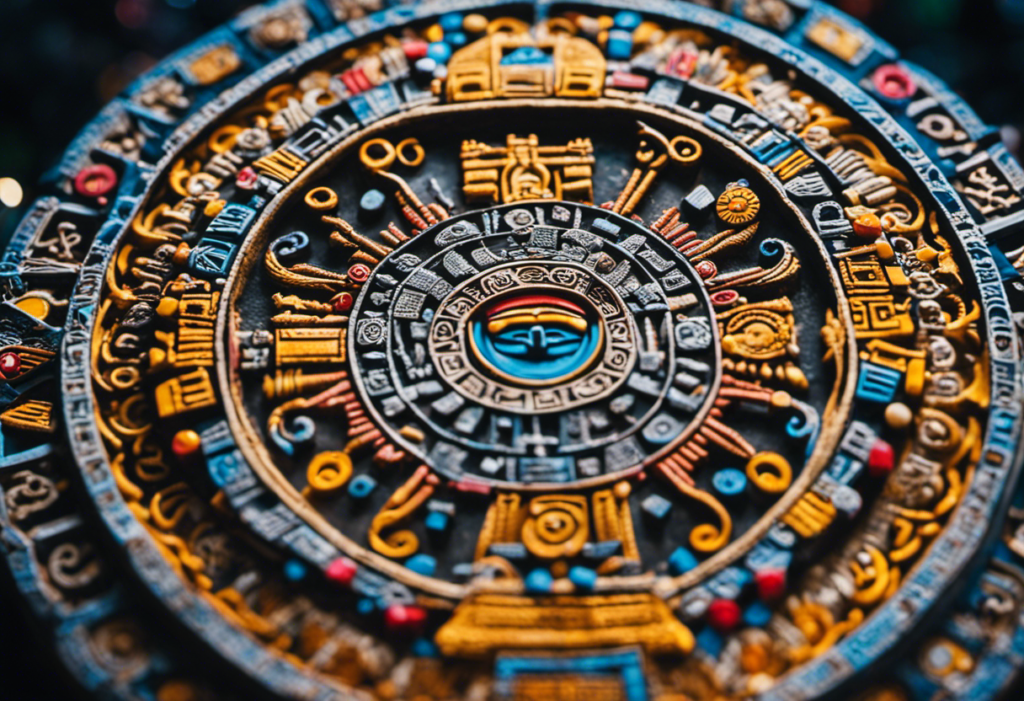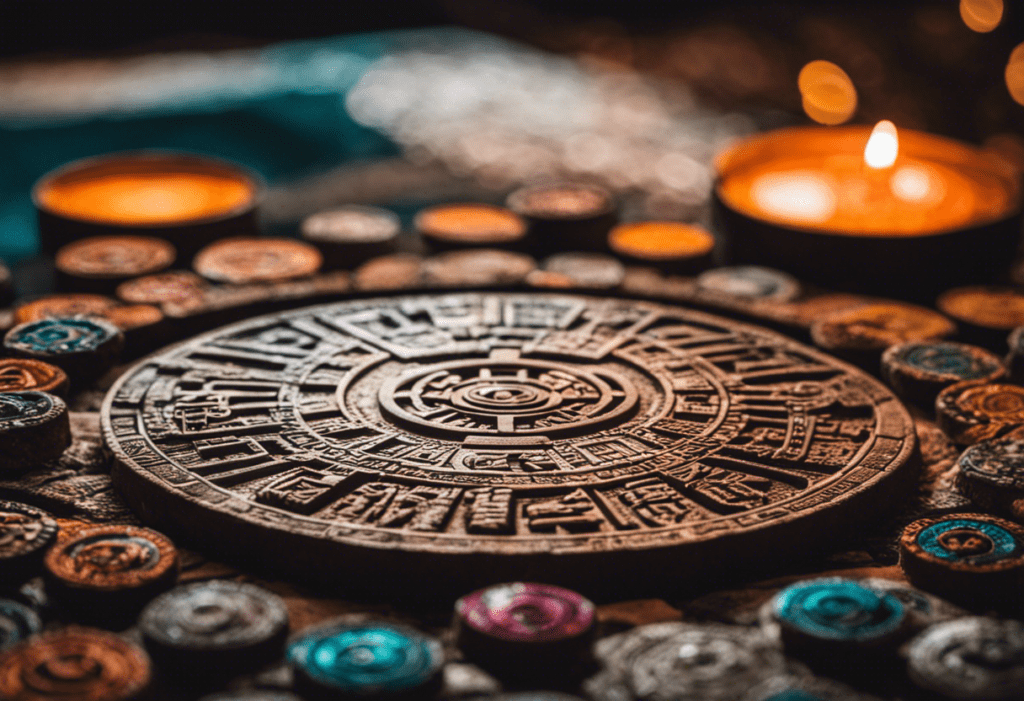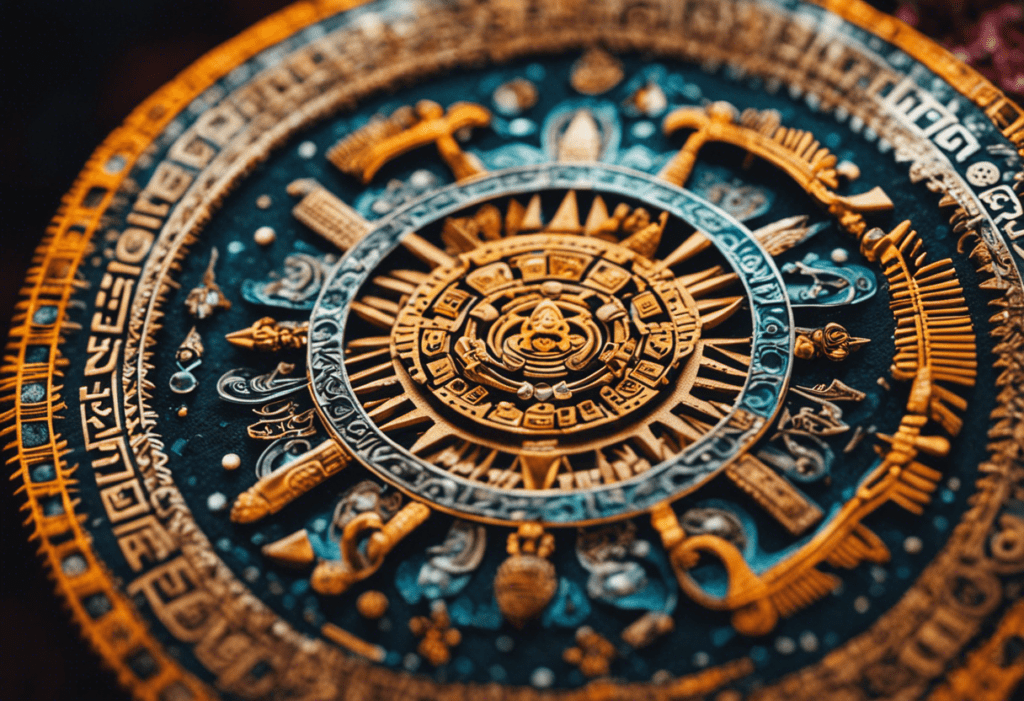Did you know that the Aztec calendar is not just a tool for tracking time, but also a rich repository of ancient symbols and meanings?
In this article, we delve into the fascinating world of Aztec calendar symbols, deciphering their hidden messages and exploring their connection to astronomy and timekeeping.
Join us as we unravel the mysteries of this ancient civilization and gain a deeper understanding of the Aztec calendar’s profound significance.
Key Takeaways
- The Aztec calendar dates back to the 14th to the 16th century and was known for its impressive architecture and complex religious beliefs.
- The Aztec Calendar Stone represented the universe and its cycles of time, with the solar calendar having 365 days for agricultural purposes and the ritual calendar having 260 days for religious ceremonies and divination.
- The symbols and glyphs of the Aztec calendar have deep meanings, representing celestial bodies, deities, and natural elements. They guided rituals and ceremonies.
- The Sun Stone is a significant artifact that depicts the five eras or suns of the Aztec worldview, symbolizing their reverence for the sun as the source of life and energy.
The History of the Aztec Calendar
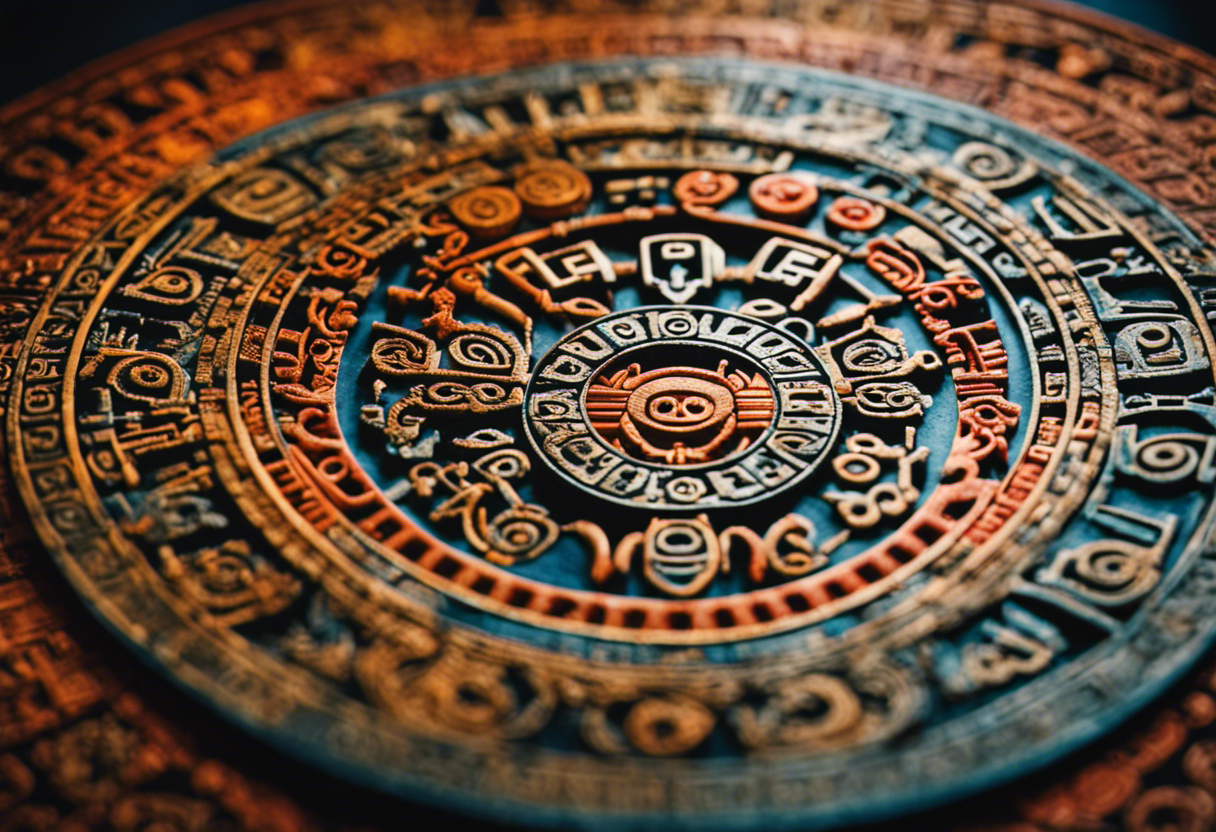

While the Aztec calendar is widely known for its complex symbols and intricate design, understanding its history is essential to comprehending its significance in Aztec culture. The history of the Aztec calendar dates back to the ancient civilization of the Aztecs, who inhabited the region of Mesoamerica from the 14th to the 16th century. The Aztecs were a highly advanced civilization, known for their impressive architectural marvels, vast empire, and complex religious beliefs.
At the center of their calendar system was the Aztec Calendar Stone, also known as the Sun Stone or the Stone of the Five Eras. This massive stone disc, measuring over 3 meters in diameter and weighing more than 20 tons, was carved with intricate symbols and glyphs that represented various aspects of Aztec cosmology and mythology. It was believed to be a representation of the universe and its cycles of time.
The Aztec calendar had both a solar and a ritual calendar. The solar calendar, known as the xiuhpohualli, consisted of 365 days and was used for agricultural purposes. The ritual calendar, known as the tonalpohualli, consisted of 260 days and was used for religious ceremonies and divination.
The Aztec calendar played a crucial role in the daily lives of the Aztecs, influencing their religious practices, agricultural activities, and social organization. It reflected their deep connection to the natural world and their belief in the cyclical nature of time. By understanding the history of the Aztec calendar, we can gain insight into the rich and complex civilization that created it.
Understanding the Symbolic Language of the Aztec Calendar


The symbolic language of the Aztec Calendar provides valuable insight into the complex belief systems and cultural practices of the Aztec civilization. The Aztec calendar symbols were not just mere representations of time but held deep spiritual meanings. Understanding these symbols is crucial in comprehending the worldview of the Aztecs and their connection to the cosmos.
Here are five key aspects to consider when examining the symbolic language of the Aztec calendar:
- Circle: The circular shape of the calendar symbolizes the cyclical nature of time and the eternal movement of the universe.
- Sunstone: The Sunstone, also known as the Aztec Calendar Stone, is one of the most iconic symbols of the Aztec calendar. It represents the sun god, Tonatiuh, and the continuous cycle of life, death, and rebirth.
- Glyphs: The intricate glyphs on the calendar are symbolic representations of various celestial bodies, deities, and natural elements. Each glyph holds its own meaning and significance within the Aztec cosmology.
- Numbers: The numbers inscribed on the calendar reflect the Aztec numerical system and play a role in determining auspicious days for rituals, ceremonies, and other important events.
- Rituals and ceremonies: The Aztec calendar symbols were deeply intertwined with religious rituals and ceremonies. They guided the Aztecs in determining the most propitious times for offerings, sacrifices, and other spiritual practices.
The Sun Stone: A Key to Aztec Calendar Symbolism


An exploration of the Aztec Sun Stone unveils its significance as a key to understanding the symbolism embedded within the Aztec calendar. The Sun Stone, also known as the Stone of the Five Eras, is one of the most famous Aztec artifacts, dating back to the 15th century. It is a massive stone disc, measuring over 12 feet in diameter and weighing around 24 tons. The stone is intricately carved with a series of concentric circles and various symbols, representing the Aztec calendar and cosmology.
The significance of the Sun Stone in Aztec culture cannot be overstated. It served as a visual representation of the Aztec worldview, connecting the realms of time, space, and the divine. The stone depicts the five eras or suns that the Aztecs believed the world had gone through, each with its own deity and cosmic cycle. The artistic elements of the Sun Stone, such as the detailed carvings and intricate patterns, reflect the Aztec’s advanced artistry and their deep understanding of the celestial and natural world.
The Sun Stone also symbolizes the Aztec’s reverence for the sun, which they considered the source of life and energy. It portrays the sun god Tonatiuh at the center, surrounded by other deities and celestial symbols. The stone’s circular shape represents the cyclical nature of time and the continuous cycle of life, death, and rebirth.
Deciphering the Aztec Calendar’s Glyphs and Symbols
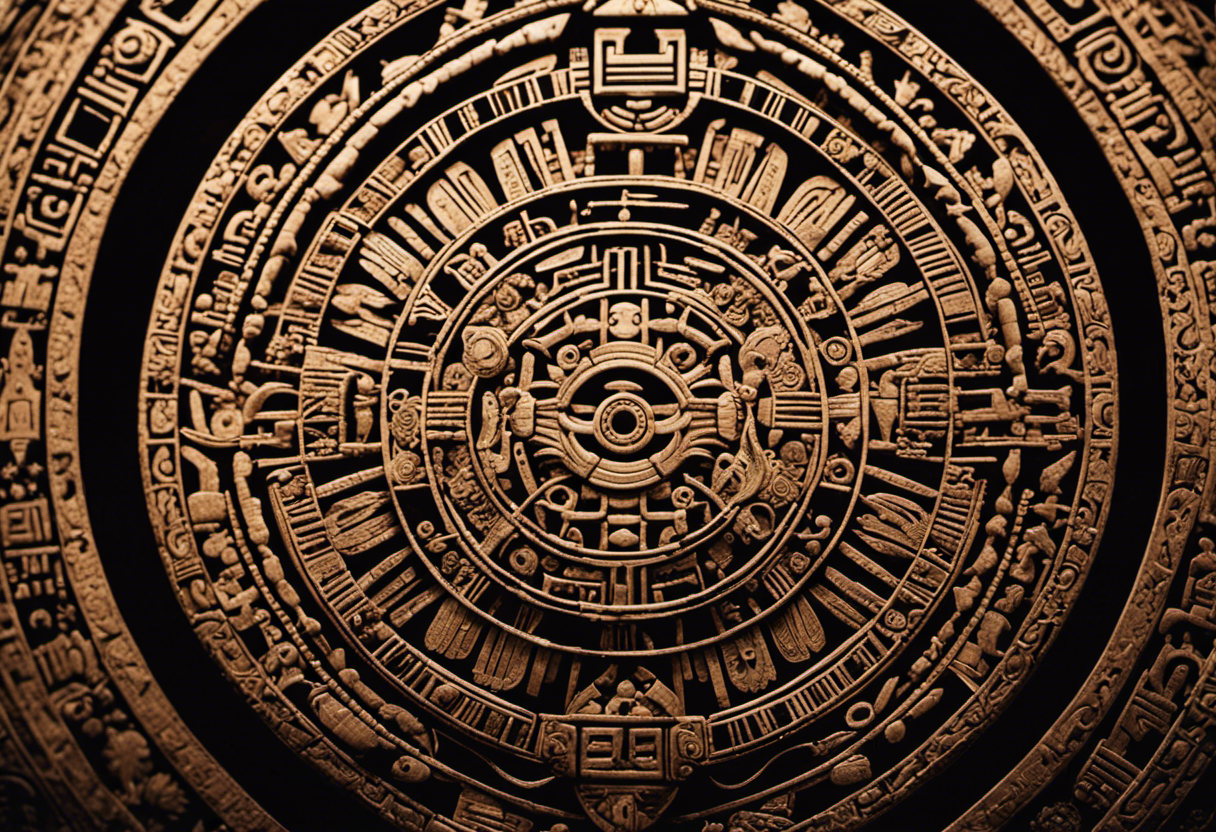

Many scholars and experts have extensively studied and analyzed the intricate glyphs and symbols of the Aztec calendar to unravel their hidden meanings. The Aztec calendar, known as the Sun Stone or the Stone of the Five Eras, is a complex system of hieroglyphic symbols that reflect the cosmological beliefs and religious practices of the Aztec civilization. Decoding these symbols requires a deep understanding of Aztec mythology, astronomy, and the cultural context in which the calendar was created.
To decipher the Aztec calendar’s glyphs and symbols, researchers have employed various methods and approaches. Here are five key techniques used in the process of decoding these enigmatic symbols:
- Comparative Analysis: Scholars compare the Aztec calendar symbols with other Mesoamerican calendars and artistic representations to identify similarities and differences.
- Iconographic Analysis: Experts study the visual elements and motifs within the symbols to determine their possible meanings and associations.
- Linguistic Analysis: Linguists analyze the Aztec language and its hieroglyphic writing system to decipher the phonetic and semantic aspects of the symbols.
- Historical Context: Researchers explore the historical and cultural context of the Aztec civilization to understand the symbolic significance of the calendar symbols within their religious and societal framework.
- Astronomical Alignment: Astronomers study the alignment of the calendar symbols with celestial bodies and events to uncover their astronomical and astrological meanings.
Exploring the Meaning Behind Aztec Calendar Patterns
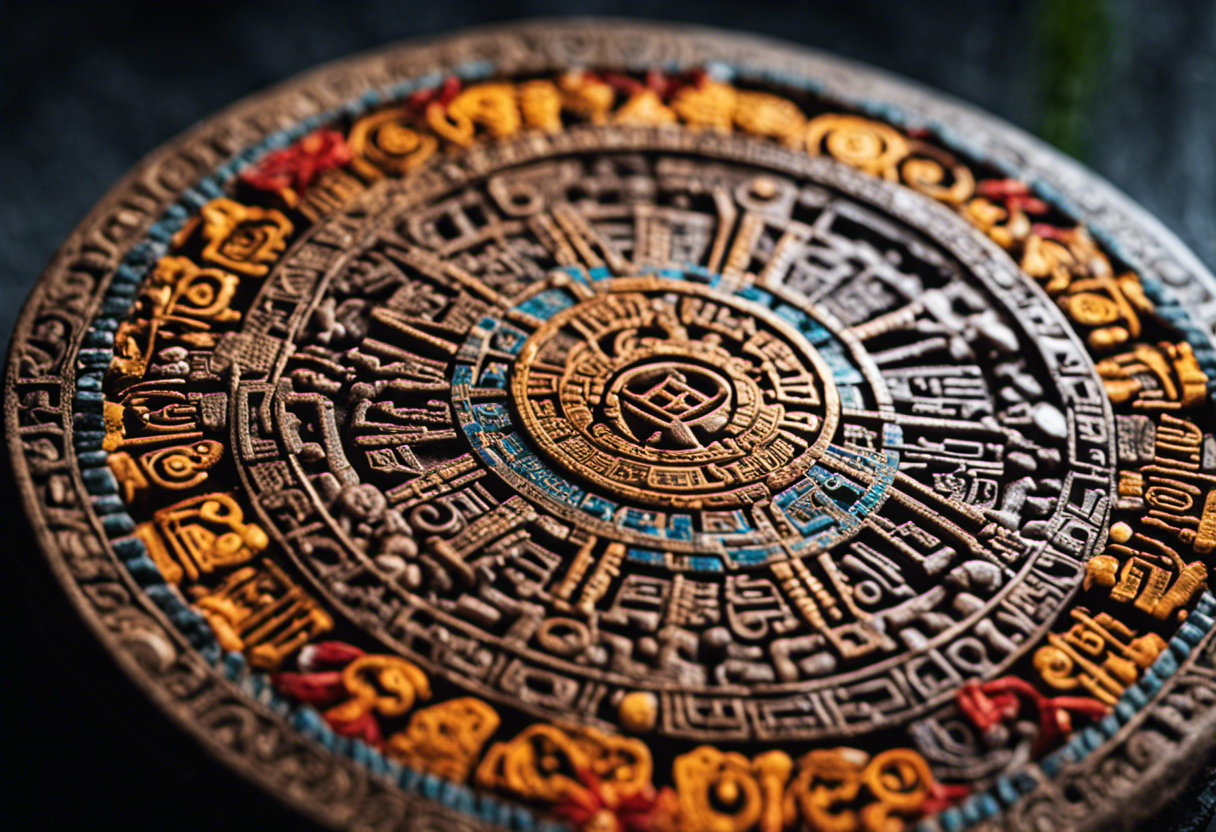

The exploration of Aztec calendar patterns involves the symbolic interpretations and cultural significance of the symbols used.
By analyzing the patterns, researchers gain insight into the Aztec civilization’s beliefs, cosmology, and understanding of time.
These patterns provide a visual language that allows us to understand the complex interplay between the celestial and earthly realms in Aztec culture.
Symbolic Interpretations of Patterns
Several different interpretations can be made regarding the meaning behind the intricate patterns found in the Aztec calendar. These patterns held great significance in Aztec culture and were believed to represent various aspects of the natural and spiritual world.
Here are five symbolic interpretations of the patterns:
- Celestial bodies: Many of the patterns found in the Aztec calendar are believed to represent celestial bodies such as the sun, moon, and stars. These symbols were associated with the gods and their power over the universe.
- Nature and agriculture: Some patterns are thought to represent elements of nature and agricultural cycles. They symbolize the seasons, rainfall, and fertility, reflecting the Aztec’s deep connection with the natural world.
- Mythology and deities: The patterns also depict mythological stories and the gods worshipped by the Aztecs. Each deity had its own unique symbol, representing their attributes and powers.
- Time and cycles: The patterns in the calendar are linked to the concept of time and cycles. They represent the ongoing nature of life, death, and rebirth, as well as the cyclical nature of the universe.
- Rituals and ceremonies: The patterns served as a guide for religious rituals and ceremonies. They provided a framework for the Aztecs to connect with the spiritual realm and seek blessings from the gods.
These symbolic interpretations reflect the deep cultural beliefs and spiritual practices of the Aztec civilization. Through their intricate patterns, the Aztec calendar offered a rich tapestry of meaning and symbolism.
Cultural Significance of Symbols
A significant number of symbols found in the Aztec calendar hold deep cultural meaning, offering insights into the beliefs and practices of the Aztec civilization. The cultural interpretations of these symbols reveal the significance and impact they had on Aztec society.
One such symbol is the sunstone, also known as the Calendar Stone. This intricate design represents the Aztec cosmology and their understanding of time and space. It depicts various celestial bodies, deities, and elements of nature. The sunstone was not only a tool for measuring time but also a representation of the Aztec worldview.
Another important symbol is the serpent, which was associated with Quetzalcoatl, the feathered serpent deity. The serpent symbolized wisdom, fertility, and the cycle of life and death.
These symbols played a crucial role in shaping the religious, social, and political aspects of Aztec culture and continue to hold cultural significance to this day.
The Aztec Calendar’s Connection to Astronomy and Timekeeping
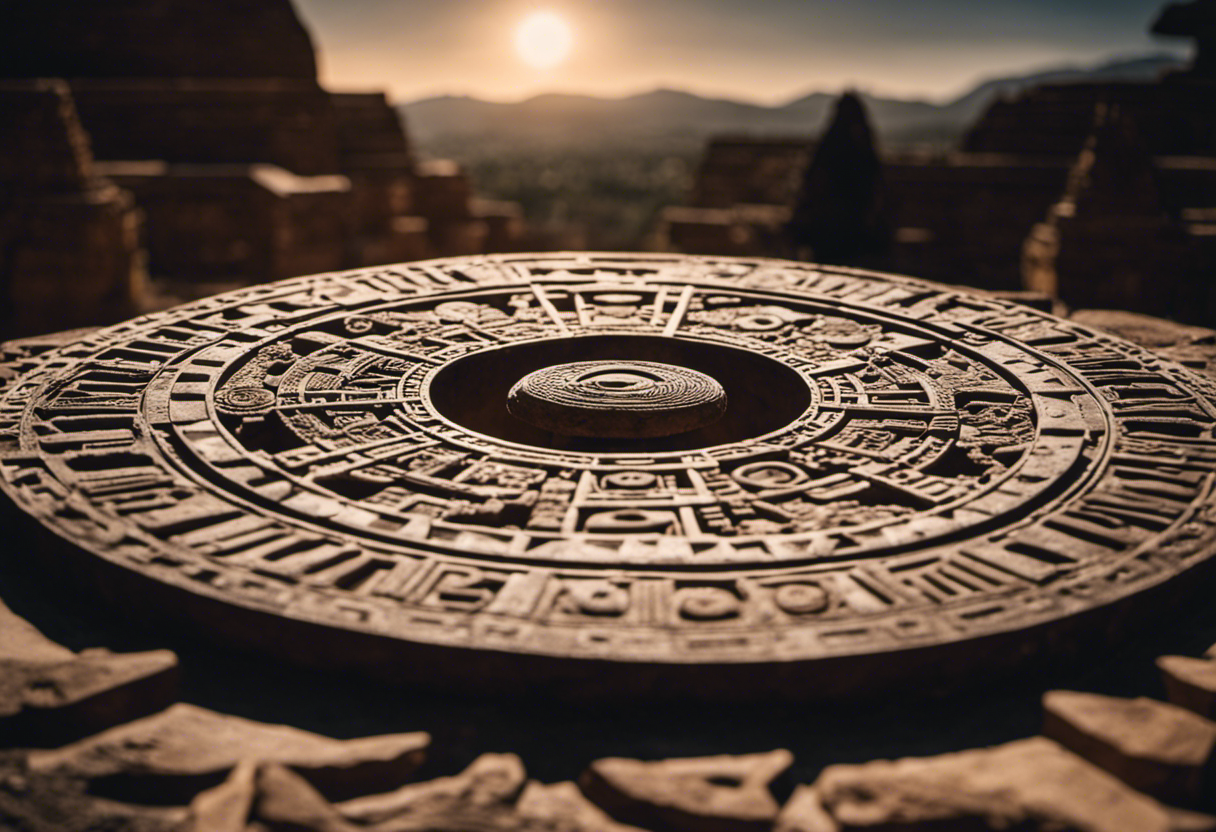

One significant aspect of the Aztec calendar is its connection to astronomy and timekeeping. The Aztecs were highly skilled astronomers and used their knowledge of celestial bodies to develop their calendar system. Here are some key points highlighting the astronomical significance and timekeeping techniques of the Aztec calendar:
- Celestial Observations: The Aztecs closely observed the movements of the sun, moon, and other celestial bodies to track time and determine important events such as agricultural cycles and religious ceremonies.
- Sunstone: The Aztec calendar stone, also known as the Sunstone, is a renowned example of their astronomical knowledge. It depicts various celestial symbols and is believed to represent the Aztec cosmos and their understanding of time.
- Solar Year: The Aztec calendar was based on a solar year of 365 days, divided into 18 months of 20 days each, with an additional 5-day period known as the nemontemi. This allowed them to align their calendar with the solar cycle.
- Venus: The Aztecs had a special focus on Venus, considering it a significant celestial body. They observed its movements and incorporated them into their calendar system, as it played a vital role in their religious beliefs and practices.
- Ritual Timekeeping: The Aztecs used the calendar for various ritualistic purposes, including determining the most auspicious times for religious ceremonies and sacrifices.
The Aztec calendar’s connection to astronomy and timekeeping showcases the advanced knowledge and understanding of celestial phenomena possessed by the Aztec civilization. It reflects their sophisticated approach to tracking time and their deep reverence for the celestial world.
Unraveling the Mysteries of Aztec Calendar Prophecies
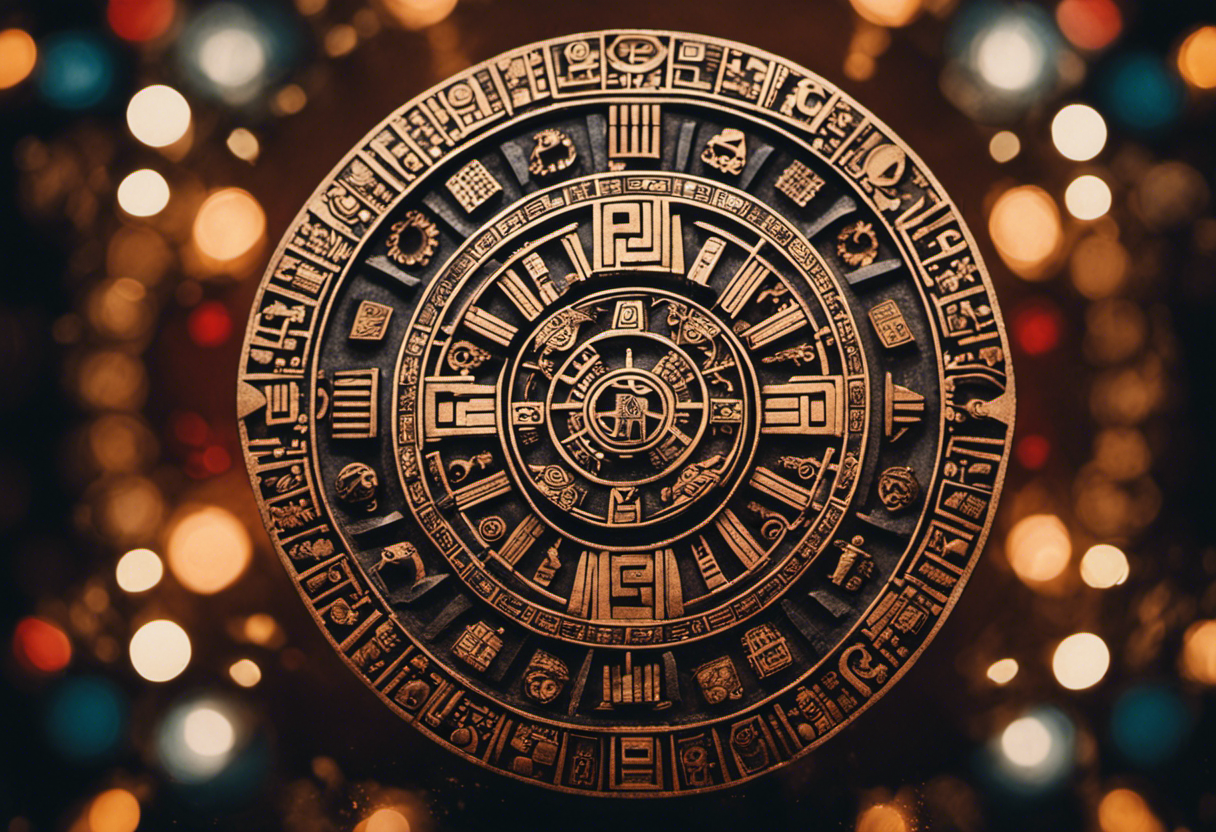

The mysteries surrounding Aztec calendar prophecies have long fascinated researchers and historians.
One point of discussion is the symbolic interpretations of these prophecies, which offer insight into the Aztec worldview and beliefs.
Additionally, the historical significance of the Aztec calendar in relation to these prophecies cannot be overlooked, as it provides a context for understanding the cultural and societal implications of these predictions.
Symbolic Interpretations of Prophecies
As we delve into the symbolic interpretations of Aztec calendar prophecies, it becomes crucial to unravel the mysteries that lie within them. The Aztecs had a deep understanding of the celestial bodies and believed that they held immense power and influence over human life. Their calendar system, known as the Tonalamatl, consisted of 260 days and was used to predict the future and interpret the meaning of events.
Here are five key points to consider when examining the symbolic interpretations of Aztec calendar prophecies:
- The Aztecs believed that the gods communicated with them through signs and symbols, and the calendar was a means of deciphering these messages.
- Each day of the calendar had its own unique symbol, which represented a specific energy or aspect of life.
- The calendar was used to predict the outcome of battles, the success of crops, and even the fate of individuals.
- The Aztecs believed in cyclical time, and the calendar helped them understand the repeating patterns of life and the universe.
- Symbolic interpretations of prophecies were deeply intertwined with cultural beliefs and rituals, reflecting the Aztec worldview and their connection to the divine.
Through the study of Aztec calendar symbols and their symbolic interpretations, we can gain insight into the complex and fascinating belief system of the Aztec civilization.
Historical Significance of Calendar
Throughout the centuries, historians have frequently attempted to unravel the mysteries surrounding the historical significance of the Aztec calendar and its prophecies. Understanding the historical context of the calendar is crucial to comprehending its importance in Aztec society.
Archeological findings have provided valuable insights into the Aztec civilization and their understanding of time. The calendar was not only a tool for tracking time but also served as a complex system for religious and agricultural purposes. It allowed the Aztecs to organize their society, determine favorable times for planting and harvesting crops, and plan religious ceremonies and rituals.
Furthermore, the calendar played a vital role in the Aztec belief system, with prophecies used to predict future events and guide decision-making. The historical significance of the calendar lies in its role as a central aspect of Aztec life, providing structure, guidance, and a connection to the divine.
Cultural Beliefs and Predictions
Cultural beliefs and predictions intertwine within the intricate system of Aztec calendar prophecies, providing a glimpse into the spiritual and metaphysical dimensions of Aztec society. The Aztecs believed that the calendar was a sacred tool that allowed them to connect with the divine and understand the cyclical nature of time. Their cultural practices and indigenous traditions influenced their interpretations of the calendar symbols and predictions.
Here are five key aspects of Aztec cultural beliefs and predictions related to the calendar:
- The Aztecs believed that the calendar held the power to predict the future and guide their actions accordingly.
- Rituals and ceremonies were conducted to honor and appease the gods, seeking their favor and protection.
- The calendar was used to determine auspicious days for important events such as marriages, battles, and agricultural activities.
- Prophecies about natural disasters, political changes, and celestial events were often associated with specific calendar dates.
- The Aztecs believed that fulfilling their obligations to the gods, as dictated by the calendar, would ensure the harmony and balance of the universe.
These cultural practices and beliefs shaped the Aztec society and influenced their understanding of the world around them.
Conclusion
In conclusion, the Aztec calendar is a fascinating and complex system that holds great significance in understanding the culture and beliefs of the Aztec civilization. Through the study of its symbols, glyphs, and patterns, we can gain insight into their understanding of time, astronomy, and prophecy.
Despite the passage of centuries, the Aztec calendar continues to captivate and intrigue us. How can we not marvel at the ancient wisdom and knowledge encoded within its intricate design?

